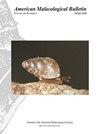Burrowing Behavior in Two Species of Infaunal, Estuarine Clams (Rangia cuneata and Polymesoda caroliniana)
IF 0.4
4区 生物学
Q4 MARINE & FRESHWATER BIOLOGY
引用次数: 0
Abstract
Abstract: A comparative burrowing study was performed using two estuarine clams, Rangia cuneata (G. B. Sowerby I, 1831) and Polymesoda caroliniana (Bosc 1801). These studies were carried out using three types of sediment (sand, silt, and clay) removed from the clam's native environment and placed into separate tanks. The number of burrowing events, in which the animals actively burrowed into the sediment, and the duration of time over which these events occurred were recorded and analyzed. There was a significant effect of sediment type on the number of burrowing events, but not so much on the duration of events. Pairwise comparisons between sediment types revealed subtle differences regardless of species. From these results, we report that sediment type can significantly influence the burrowing behavior of sympatric clams, but in different ways; and note observations on how these species physically interact and alter the substrate when burrowing.两种浮游河口蚌(Rangia cuneata和Polysoda caroliniana)的掘穴行为
摘要/ Abstract摘要:对两种河口蛤(angia cuneata, g.b. Sowerby I, 1831)和Polymesoda caroliniana (Bosc 1801)进行了比较穴居研究。这些研究使用了三种类型的沉积物(沙子、淤泥和粘土),这些沉积物是从蛤蜊的原生环境中取出的,并放置在不同的水箱中。研究人员记录并分析了动物主动在沉积物中挖洞的次数,以及这些活动发生的持续时间。沉积物类型对挖洞事件数量有显著影响,但对事件持续时间影响不大。沉积物类型之间的两两比较揭示了不同物种的细微差异。这些结果表明,沉积物类型对同域蛤的穴居行为有显著影响,但影响方式不同;注意观察这些物种在挖洞时是如何相互作用和改变基质的。
本文章由计算机程序翻译,如有差异,请以英文原文为准。
求助全文
约1分钟内获得全文
求助全文
来源期刊
CiteScore
1.00
自引率
40.00%
发文量
1
审稿时长
>12 weeks
期刊介绍:
The American Malacological Bulletin serves as an outlet for reporting notable contributions in malacological research. Manuscripts concerning any aspect of original, unpublished research,important short reports, and detailed reviews dealing with molluscs will be considered for publication. Recent issues have included AMS symposia, independent papers, research notes,and book reviews. All published research articles in this journal have undergone rigorous peer review, based on initial editor screening and anonymous reviewing by independent expertreferees. AMS symposium papers have undergone peer review by symposium organizer, symposium participants, and independent referees.

 求助内容:
求助内容: 应助结果提醒方式:
应助结果提醒方式:


